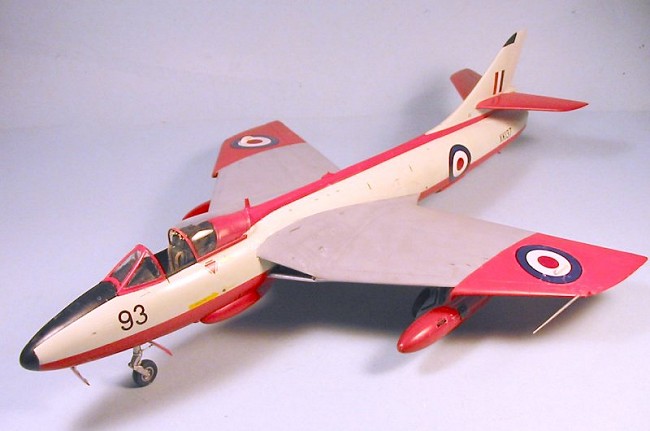
Revell 1/32 Hawker Hunter FGA.9
| KIT #: | ? |
| PRICE: | $26.50 MSRP when new |
| DECALS: | Two options |
| REVIEWER: | Tom Cleaver |
| NOTES: |

| HISTORY |
To my mind, the Hawker Hunter is aesthetically one of the best-looking jets ever designed. In that opinion, I am not alone, as many have responded favorably to the flowing lines of Britain's first successful swept-wing fighter. With the first prototype having flown July 20, 1951, the Hunter is one of the longest-serving jets in any air force, with the last of its type retired from the Royal Air Force only in 1996.
Interestingly enough, this most successful of all Britain's post-war military jets was not always considered a success. The early development of the Hunter was plagued with so many problems it seemed likely it would be replaced by the Supermarine Swift until that airplane revealed even more serious design faults.
Overcoming the gun firing problems which were causing major problems in engine operation was like dealing with the Hydra: solve one and two more would take its place.
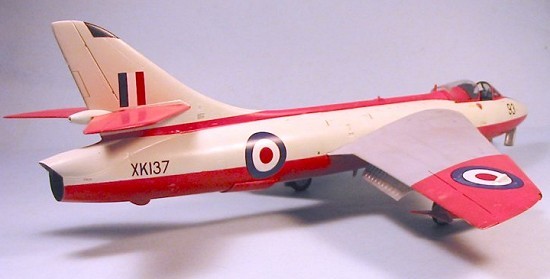 Hawker Aircraft
came late to jet aircraft, and even later to swept wings. Where the company
had a 30 year run of success with all previous designs, it seemed to lose
its footing with the Hunter. Its immediate predecessor was the straight
wing Sea Hawk, a design that was six years behind its US contemporaries
when it finally entered service with the Royal Navy in 1953. As a design,
the Hunter suffered from a too-extended gestation, which failed to take
into account very important discoveries about jet aircraft that could have
led to early modification of the design: the horizontal stabilizer was not
an all-flying type, and was in the wrong position aerodynamically. Failure
of the flaps to operate as effective air brakes led to extended tests as
to the proper location of the ventral dive brake eventually fitted. There
was aileron pitch-up stall which was only cured by the addition of a
sawtooth leading edge to the wing. What would turn out to be the biggest
fault - one shared with all other British post-war designs - was the
extreme lack of range, since the original design called for a point-defense
interceptor. There was a common joke among Hunter pilots that - without
drop tanks - the airplane could not be flown outside the airport pattern
before it ran out of gas.
Hawker Aircraft
came late to jet aircraft, and even later to swept wings. Where the company
had a 30 year run of success with all previous designs, it seemed to lose
its footing with the Hunter. Its immediate predecessor was the straight
wing Sea Hawk, a design that was six years behind its US contemporaries
when it finally entered service with the Royal Navy in 1953. As a design,
the Hunter suffered from a too-extended gestation, which failed to take
into account very important discoveries about jet aircraft that could have
led to early modification of the design: the horizontal stabilizer was not
an all-flying type, and was in the wrong position aerodynamically. Failure
of the flaps to operate as effective air brakes led to extended tests as
to the proper location of the ventral dive brake eventually fitted. There
was aileron pitch-up stall which was only cured by the addition of a
sawtooth leading edge to the wing. What would turn out to be the biggest
fault - one shared with all other British post-war designs - was the
extreme lack of range, since the original design called for a point-defense
interceptor. There was a common joke among Hunter pilots that - without
drop tanks - the airplane could not be flown outside the airport pattern
before it ran out of gas.
Eventually, the Hunter emerged from all this development (which included several test flights with extensive criticisms from Chuck Yeager during 1952-53) with handling qualities that became the standard against which other military aircraft would be judged. The airframe was so strong that no Hunter was ever lost to midair structural failure. The firepower of four 30mm cannon was such that any target that got in a Hunter's sights could be shredded with a 2 second burst. 1,972 Hunters were built, of which 400 were later re-manufactured for service with second air forces, and it served with no less than 21 different world air forces, a record only bettered by the MiG-17.
During the early life of the aircraft, marks alternated between power by
the Rolls-Royce Avon and Sapphire engines. Production finally centered on
the Avon-powered Hunter with the F.6, which came into operational service
beginning in 1955. This was followed by the FGA.9, which was optimized for
low altitude work in ground attack and tactical air combat. The FGA.9
featured a cutout in the wing flaps to allow carriage of larger drop tanks,
with drop tan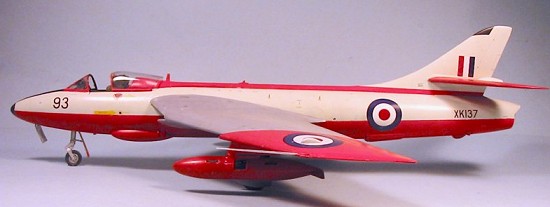 ks also
being carried on the outer pylons if necessary in place of ordnance. Many
F.6s were rebuilt as FGA.9s, in addition to the 150 or so that were new
production in the late 1950s, with most of the rebuilds going to foreign
air forces. Interestingly enough, the main weapon for ground attack by the
FGA.9 was the same 60-pound RP used by its ancestor the Typhoon during the
Second World War. In service with other air forces, the Hunter was
eventually cleared to carry the Sidewinder.
ks also
being carried on the outer pylons if necessary in place of ordnance. Many
F.6s were rebuilt as FGA.9s, in addition to the 150 or so that were new
production in the late 1950s, with most of the rebuilds going to foreign
air forces. Interestingly enough, the main weapon for ground attack by the
FGA.9 was the same 60-pound RP used by its ancestor the Typhoon during the
Second World War. In service with other air forces, the Hunter was
eventually cleared to carry the Sidewinder.
By the early 1970s, Hunters were being used as advanced trainers, mostly stationed at RAF Valley, where graduate pilots were introduced to high-powered air combat maneuvering and firing ordnance. These Hunters were painted in the RAF high-visibility trainer scheme of red, white and grey. Several FGA.9s were used by the RAF and the Fleet Air Arm through the 1980s in secondary operational roles and also to give pilots of other - more expensive aircraft - high performance jet time at a lower cost than would have been the case flying their Lightnings, Phantoms, or Buccaneers.
We have a Hunter based at Chino nowadays that is still in its Fleet Air Arm scheme. Beset by mechanical problems it does not fly often, though everyone who passes it out on the flight line pauses to look at it and comment on the beauty of its lines.
| THE KIT |
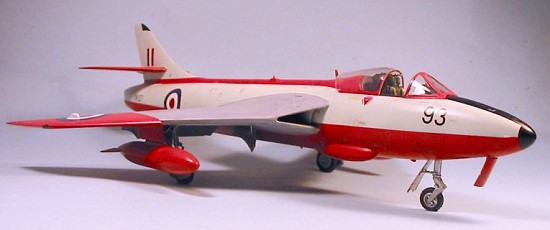 Revell answered
Modelers' "want lists" in 1998 with the release of this 1/32 Hunter, which
then promptly became a shelf-sitter - as have nearly every model ever
released in response to the pleas of modelers for this or that kit. This is
unfortunate, because this Hunter is probably the most accurate kit of the
airplane released by anyone. Produced "to a price," it is simple in
construction and does not have much of the detail modelers seem to prefer
in this scale. However, what is there is quite adequate to make a good
model - the only real need being a more detailed seat, and there are 1/32
Martin-Baker seats available for those who want them. The kit originally
sold for around $25 when first released.
Revell answered
Modelers' "want lists" in 1998 with the release of this 1/32 Hunter, which
then promptly became a shelf-sitter - as have nearly every model ever
released in response to the pleas of modelers for this or that kit. This is
unfortunate, because this Hunter is probably the most accurate kit of the
airplane released by anyone. Produced "to a price," it is simple in
construction and does not have much of the detail modelers seem to prefer
in this scale. However, what is there is quite adequate to make a good
model - the only real need being a more detailed seat, and there are 1/32
Martin-Baker seats available for those who want them. The kit originally
sold for around $25 when first released.
I found this particular one shelf-sitting at a local hobby shop and was able to pick it up at the original price, which is a very good bargain when you consider that most recently I have seen the kit in its Revell of Germany box on the same shelf for $54 - a price that to me is vastly inflated for what's there. That said, one can frequently find the kit at shows on dealer's tables for quite reasonable prices. Aeromaster released at least two aftermarket sheets I am aware of for the kit, so there are more markings options available than what is in the box. (Actually they did four sheets and and one of stencils; most of those are in the decal review index. Ed)
| CONSTRUCTION |
 Assembly is very straightforward. If you follow the instructions, there
will be no problems, and I only found myself needing to use Mr. Surfacer
500 on the fuselage centerline and the centerline of the underwing drop
tanks. A considerable amount of weight is needed to insure nose sitting,
and I filled up the area in front of the cockpit above the nose gear well,
as well as the area immediately behind the cockpit.
Assembly is very straightforward. If you follow the instructions, there
will be no problems, and I only found myself needing to use Mr. Surfacer
500 on the fuselage centerline and the centerline of the underwing drop
tanks. A considerable amount of weight is needed to insure nose sitting,
and I filled up the area in front of the cockpit above the nose gear well,
as well as the area immediately behind the cockpit.
The cockpit was painted black, and drybrushed with aluminum to "pop out" detail. 1/32 scale instrument faces from a ProModeler decal sheet were used for the instrument panel.
I used Cutting Edge 1/32 posable resin British seatbelts to improve the look of the very basic ejection seat.
| COLORS & MARKINGS |
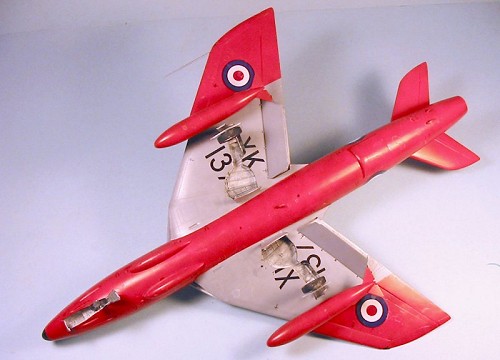 Painting:
Painting:
Having decided to do the advanced trainer scheme, I became involved in a serious bit of masking to get this right.
I first painted the wheel wells and landing gear and inner gear doors aluminum. The gear wells were packed with tissue paper and I painted the model overall white. When this was dry I completely masked off the white area of the fuselage and rudder, and painted the inner wings light aircraft grey. This area was masked off when dry, and the red areas were painted with Gunze-Sangyo "Shine Red," a nice bright shade close to scarlet.
Decals:
With the model given a coat of Future, I used the kit national insignia, serial number and stencils. These went on without problem.
Final finish and assembly:
I gave the model an overall coat of Xtracrylix Satin varnish, then attached the landing gear. I unmasked the canopy and posed it in the open position.
| CONCLUSIONS |
Like I said - I like the Hunter, and I like this kit. It is easy to build, and presents no problems. Those who want to super detail it would have a very good-looking model as a result. The only thing it really needs besides aftermarket decals is a good resin seat, which improves the look of everything 100 percent. I will be putting one in as soon as I can lay hands on it.
October 2005
Review kit courtesy of my wallet.
Copyright ModelingMadness.com. All rights reserved. No reproduction in part or in whole without express permission.
If you would like your product reviewed fairly and fairly quickly, please contact the editor or see other details in the Note to Contributors.